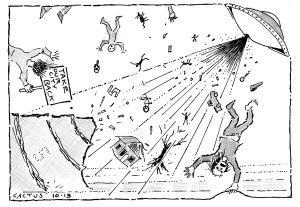By George Sibley
The Anthropocene: I’ve been thinking about this concept a lot, but nature and culture both kicked in recently with ugly news that both affirms and challenges the idea of an Anthropocene Epoch on planet earth.
To refresh your mind (or assault it if the concept is new to you), “Anthropocene” is a new name that scientists from a number of fields, including geology, are proposing for the current geological epoch, known to this point as the “Holocene Epoch.” Some scientists sees the Anthropocene Epoch starting only 200 years ago, when humans began the large-scale use of fossil fuels. Others see it going back the full 11,700 years of the Holocene, when the Big Ice of the Pleistocene Epoch receded – “went back for more rocks,” as New England farmers say – and humans began cultivating land.
But today, Anthropocene proponents can point to lots of evidence that we humans have become a major driver of change on planet Earth – on a planetary scale. Some of the big changes we have wrought are conscious and deliberate, the execution of plans for meeting the needs of our swarming species. We have changed the “nature” of many of the world’s rivers, slowing and evening out their former wild runs to the oceans – even in some cases, like the Colorado River, not “wasting” any of that fresh water to the ocean, but putting all of its water to land uses. We have converted vast stretches of land from diverse ecosystems to huge monocultural systems in order to feed vast and growing populations. We have created huge cities that replace natural species diversity with concentrated human cultural diversity in environments that are almost entirely manmade.
These manmade changes in systems around the planet have also imposed on the planet a lot of unintended consequences, which engender further changes on large regional or global scales. Huge quantities of disturbed soil that took millions of years to form get blown or washed off of megafarms in decades, along with fertilizers and pesticides, resulting in silted rivers and “dead zones” in the ocean. Moving water from existing ecosystems to new human systems causes collapses in the former. There are many “manmade deserts”; many of our impacts in the Anthropocene look as randomly destructive as the geological events of any other epoch.
And now we have “discovered” an even larger unintended consequence: we have been unconsciously changing the vast and complex climate of the planet itself, by returning to the active carbon cycle huge quantities of fossil-fuel carbon that were removed from that cycle millions of years ago. Carbon gases are trapping heat in our atmosphere, with the same kind of consequences as we get from heating a pan of water to the boiling point.
Which brings me to nature’s recent ugly news: flooding from the “500-year” rains along Colorado’s Front Range in mid-September. The rains themselves were a good example of the “extreme weather events” we are warned to expect from global climate change. That situation was made worse, however, by rapid runoff and debris flows from burned-over land, due to wildfires whose intensity and extent is attributed in part to a century of Anthropocene fire suppression, as well as an ongoing drought. This occurrance may not actually be “drought” at all but “the new normal” for a climate predicted to be drier overall just due to the drying potential of higher average temperatures. The average flow for the Colorado River over the past two decades is 10 percent below the 20th-century average. Welcome to the Anthropocene.
I know of course that some of you simply refuse to believe that the very nature of the planet could be changed by little ol’ us and our works, which Ralph Waldo Emerson described (two centuries ago, pre-petroleum) as “insignificant, a little chipping, baking, patching, and washing.” But thanks to another ugly piece of news this past week, I know also that a full-scale, documented dissertation elaborating in detail the human planetary changes sketched out above would not change the minds of those who refuse to believe what is happening; it’s not a rational thing for them.
That second ugly bit of news was a report on a couple of separate studies of the human mind at work – one by Yale law professor Dan Kahan, the other by Dartmouth government professor Brendan Nyhan. Both men were exploring aspects of the question, “Do facts matter in human beliefs and decisions?” And both concluded independently that not only do the facts not matter; when the facts contradict a belief or other mental construct, however fantastic, the belief is actually strengthened by the contradictory facts. In other words, Senator James Inhofe and all his braying colleagues are not going to be convinced by the drowning of Boulder, the frying of the Southwest, the rise of oceans, or the melting of Antarctica, that there might be something to this climate change business. He is more likely to believe even more firmly that it is all an elaborate liberal plot against the righteous God-given American economy.
So where does that leave democracy, American-style, as a system for addressing climate change? Either to reduce its long-term impacts through cutting back now on carbon fuels, or to adapt to those impacts that are already upon us? It is increasingly clear that American democracy has become almost entirely a one-dollar one-vote system at the national level. And those who hold the voting power (the dollars) in that system are those who benefit from the activities that are causing the changes that “precipitate” events like Boulder’s “carbon-based” flood or hurricanes on steroids like last year’s Sandy.
So if the federal government is useless for addressing climate issues, or perhaps anything else, for that matter, what do we do? Wait for it to get worse, maybe – but can it ever get bad enough to actually wake up people like the sociopaths who manage to get elected to our governments? Those studies suggest that it can’t ever get so bad that beliefs will be changed by new perceptions of reality.
Way back in the 1990s, when I was teaching at Western here in Gunnison, I used what now looks like a really prescient videotape (remember those?): “After the Warming,” produced by James Burke, the “Connections” guy. Considering that he made the video in the late 1980s, it is a remarkable presentation. He pushed things a little faster than they have actually happened, but that’s just dramatic license. He foresaw much of the world resolving to do something about “global warming” in the 1990s, with only the primitive-capitalist economies like the United States holding out against it. But then an extended drought which he projected for the late 1990s brought even the United States around, and a “planetary authority” was created (based in Japan), run by technocrats appointed for their knowledge rather than sociopaths elected for their chutzpah.
I do not want to get into Burke’s global solution here – although it was interesting: an equitable population-based division of “carbon credits” among all nations, based on the amount of additional carbon the planet could absorb, with undeveloped nations able to trade their unused credits to developed nations in exchange for technical assistance in non-carbon energy systems and the money to develop them.
But the point to take away from Burke’s “solution” may be this: if the accumulating negative consequences of our Anthropocene activities get too onerous, forget democracy – governance may need to get authoritarian.
Meanwhile, in local news: The Nature Conservancy has been working quietly in the Upper Gunnison on a different kind of Anthropocene project – restoring once-wet meadows dried out by gullying. I spent an afternoon on this project with a party of volunteers, led by an old man from New Mexico, Bill Zeedyk; our objective was to patch up a meadow whose small stream had begun to gully. Zeedyk has spent a lot of his life watching streams, learning how water works on land, and learning how to “let the water do the work” in raising water tables, increasing the “sponge function” of the land.
Zeedyk builds small structures that subtly nudge the water around in places that are developing gullies, inducing “meandering” – a term almost offensive to goal-driven Americans, but a virtue in a healthy water-land relationship. (“Meandering” might be a virtue for a culture trapped in its own psychological gullies.) Such work – carefully organized on the local level, in many different places – might be an alternative to the Hobson’s choice of a dysfunctional democracy or Burke’s “planetary authority.” People just getting after the damage, down on the ground where they live, one gully at a time. That might be where the Anthropocene begins to get intelligent. It won’t change the climate back, but as Zeedyk says, “We have to learn to be a little humble.”
George Sibley can often be found in the Upper Gunnison valley, leaning on a shovel and contemplating the Anthropocene.





Splendid piece on man-centered effects on our planet. Sibley, as always, is a masterful science writer.